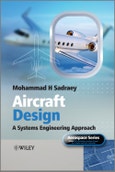A comprehensive approach to the air vehicle design process using the principles of systems engineering
Due to the high cost and the risks associated with development, complex aircraft systems have become a prime candidate for the adoption of systems engineering methodologies. This book presents the entire process of aircraft design based on a systems engineering approach from conceptual design phase, through to preliminary design phase and to detail design phase.
Presenting in one volume the methodologies behind aircraft design, this book covers the components and the issues affected by design procedures. The basic topics that are essential to the process, such as aerodynamics, flight stability and control, aero-structure, and aircraft performance are reviewed in various chapters where required. Based on these fundamentals and design requirements, the author explains the design process in a holistic manner to emphasise the integration of the individual components into the overall design. Throughout the book the various design options are considered and weighed against each other, to give readers a practical understanding of the process overall.
Readers with knowledge of the fundamental concepts of aerodynamics, propulsion, aero-structure, and flight dynamics will find this book ideal to progress towards the next stage in their understanding of the topic. Furthermore, the broad variety of design techniques covered ensures that readers have the freedom and flexibility to satisfy the design requirements when approaching real-world projects.
Table of Contents
Preface xv
Series Preface xix
Acknowledgments xxi
Symbols and Acronyms xxiii
1 Aircraft Design Fundamentals 1
1.1 Introduction to Design 1
1.2 Engineering Design 4
1.3 Design Project Planning 8
1.4 Decision Making 10
1.5 Feasibility Analysis 12
1.6 Tort of Negligence 15
References 17
2 Systems Engineering Approach 19
2.1 Introduction 19
2.2 Fundamentals of Systems Engineering 20
2.3 Conceptual System Design 23
2.4 Preliminary System Design 29
2.5 Detail System Design 30
2.6 Design Requirements 33
2.7 Design Review, Evaluation, and Feedback 34
2.8 Systems Engineering Approach in Aircraft Design 37
References 47
3 Aircraft Conceptual Design 49
3.1 Introduction 49
3.2 Primary Functions of Aircraft Components 50
3.3 Aircraft Configuration Alternatives 52
3.4 Aircraft Classification and Design Constraints 62
3.5 Configuration Selection Process and Trade-Off Analysis 68
3.6 Conceptual Design Optimization 74
Problems 86
References 92
4 Preliminary Design 93
4.1 Introduction 93
4.2 Maximum Take-Off Weight Estimation 94
4.3 Wing Area and Engine Sizing 113
4.4 Design Examples 145
Problems 155
References 158
5 Wing Design 161
5.1 Introduction 161
5.2 Number of Wings 164
5.3 Wing Vertical Location 165
5.4 Airfoil Section 170
5.5 Wing Incidence 195
5.6 Aspect Ratio 198
5.7 Taper Ratio 203
5.8 The Significance of Lift and Load Distributions 206
5.9 Sweep Angle 209
5.10 Twist Angle 223
5.11 Dihedral Angle 226
5.12 High-Lift Device 230
5.13 Aileron 241
5.14 Lifting-Line Theory 242
5.15 Accessories 246
5.16 Wing Design Steps 249
5.17 Wing Design Example 250
Problems 259
References 264
6 Tail Design 265
6.1 Introduction 265
6.2 Aircraft Trim Requirements 268
6.4 Tail Configuration 285
6.5 Canard or Aft Tail 294
6.6 Optimum Tail Arm 298
6.7 Horizontal Tail Parameters 301
6.8 Vertical Tail Design 317
6.9 Practical Design Steps 329
6.10 Tail Design Example 331
Problems 336
References 340
7 Fuselage Design 341
7.1 Introduction 341
7.2 Functional Analysis and Design Flowchart 341
7.3 Fuselage Configuration Design and Internal Arrangement 345
7.4 Ergonomics 346
7.5 Cockpit Design 350
7.6 Passenger Cabin Design 360
7.7 Cargo Section Design 368
7.8 Optimum Length-to-Diameter Ratio 372
7.9 Other Fuselage Internal Segments 380
7.10 Lofting 388
7.11 Fuselage Design Steps 394
7.12 Design Example 395
Problems 406
References 410
8 Propulsion System Design 413
8.1 Introduction 413
8.2 Functional Analysis and Design Requirements 414
8.3 Engine Type Selection 416
8.4 Number of Engines 436
8.5 Engine Location 439
8.6 Engine Installation 448
8.7 Propeller Sizing 456
8.8 Engine Performance 461
8.9 Engine Selection 462
8.10 Propulsion System Design Steps 464
8.11 Design Example 467
Problems 471
References 478
9 Landing Gear Design 479
9.1 Introduction 479
9.2 Functional Analysis and Design Requirements 481
9.3 Landing Gear Configuration 484
9.4 Fixed, Retractable, or Separable Landing Gear 494
9.5 Landing Gear Geometry 497
9.6 Landing Gear and Aircraft Center of Gravity 516
9.7 Landing Gear Mechanical Subsystems/Parameters 524
9.8 Landing Gear Design Steps 528
9.9 Landing Gear Design Example 529
Problems 539
References 544
10 Weight of Components 547
10.1 Introduction 547
10.2 Sensitivity of Weight Calculation 549
10.3 Aircraft Major Components 553
10.4 Weight Calculation Technique 556
10.5 Chapter Examples 565
Problems 570
References 573
11 Aircraft Weight Distribution 575
11.1 Introduction 575
11.2 Aircraft Center of Gravity Calculation 578
11.3 Center of Gravity Range 585
11.4 Longitudinal Center of Gravity Location 590
11.5 Technique to Determine the Aircraft Forward and Aft Center of Gravity 598
11.6 Weight Distribution Technique 606
11.7 Aircraft Mass Moment of Inertia 615
11.8 Chapter Example 620
Problems 624
References 630
12 Design of Control Surfaces 631
12.1 Introduction 631
12.2 Configuration Selection of Control Surfaces 637
12.3 Handling Qualities 638
12.4 Aileron Design 654
12.5 Elevator Design 670
12.6 Rudder Design 685
12.7 Aerodynamic Balance and Mass Balance 713
12.8 Chapter Examples 723
Problems 745
References 752
Appendices 755
Appendix A: Standard Atmosphere, SI Units 755
Appendix B: Standard Atmosphere, British Units 756
Index 757








